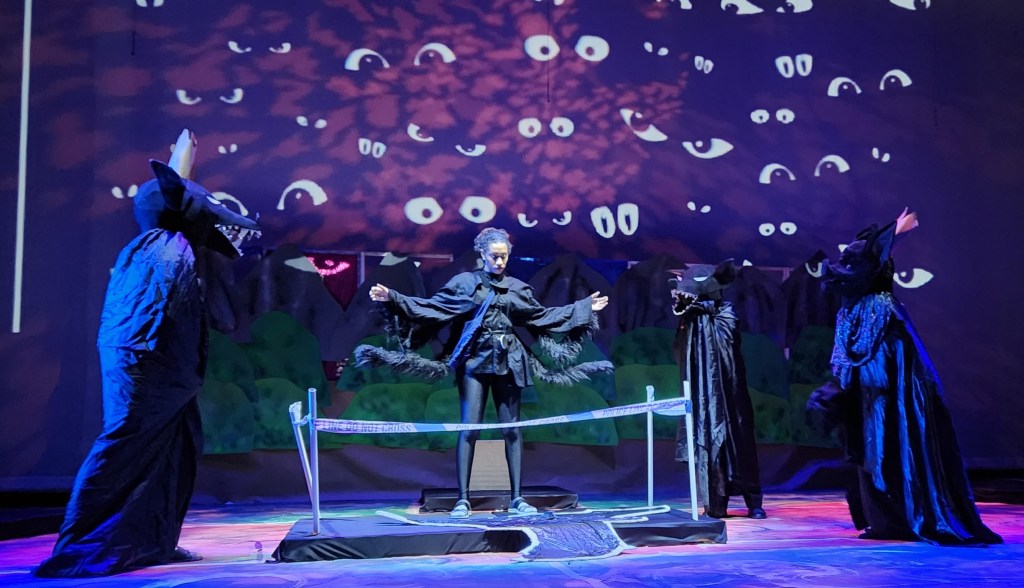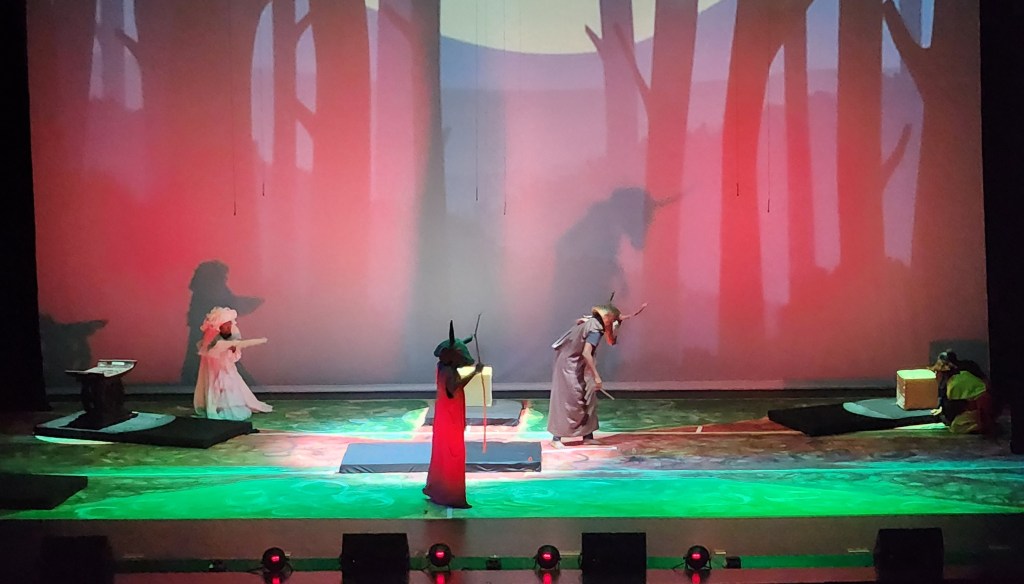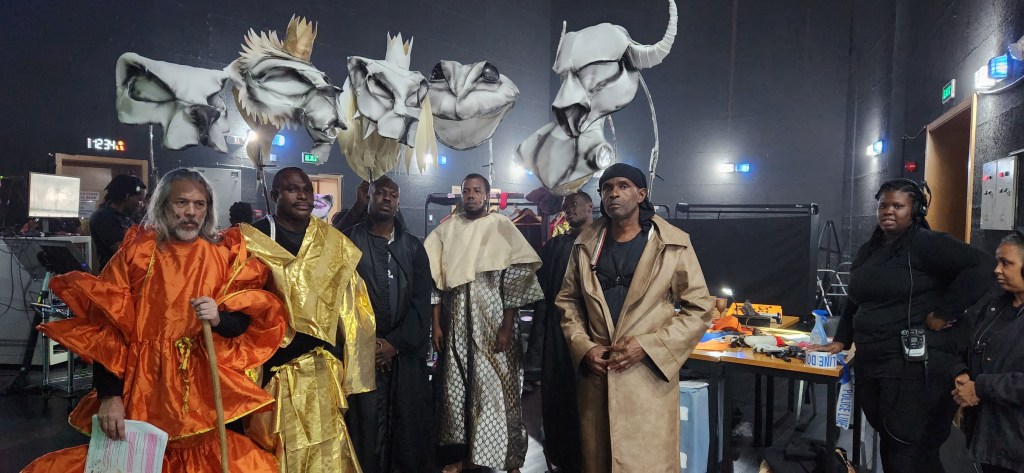Between April and May 2023, the first-time folklore festival – ’The Season of Anansi’, featured a series of workshops and events orchestrated by multi-media artist, Rubadiri Victor in tribute to the late Mark Akini Nottingham, an original member of the Wire Bend Folklore Theatre group, whose passing plunged the local creative community into mourning. The season was brought to a close with the staging of ‘Anansi and The Book of Night’, a theatrical production adapted from Victor’s novel of the same name. This is the resurgence of the performing group, which made its debut in 2015 with the prequel, ‘Anansi and the 10 Dragons’. Of the ten (10) shows carded, I chaperoned almost 100 of my students to the opening performance on Wednesday 10th May, at the Southern academy for the Performing Arts (SAPA).

Considering that this was a matinee performance, and I did not watch the show till the end (more on that later), I would not normally publish a review. However, there are many lessons from Anansi & The Book of Night that ought to be learned by those who aspire to, and are in the business of producing work in theatre – for the sake of commitment to the craft and of setting standards.
In essence, ‘Anansi and The Book of Night’ follows the African diaspora’s archetypical antihero as she investigates a succession of mysterious and mischievous events afflicting the kingdom of animals. The ‘she’ here is no mistake, as the shapeshifting spider-god played by Renee Michelle King, is decidedly female in this play.
The costume design for this play was truly as spectacular as it was advertised to be. The creatures of the forest were represented with handcrafted heads mounted on backpacks designed by Rubadiri Victor and constructed by artisan wire benders including Keston Bethum and Ernesto Jardine, both notable for their work in the carnival arena. The suspended heads brought the splendour of mas to the theatre stage in ways much like The Lion King on Broadway. The costumes sewn by Dominique La Roche – particularly the narrator’s white ensemble- were a delight to see.

I can say with certainty that primary and secondary school teachers across the country are always eager to take their students to the theatre, and it is not unusual for schools from Toco and Tobago to make the hours-long journey to and from the theatres in south. However, Anansi and The Book of Night played to very few students, filling less than a quarter of the Sundar Popo Bahora Auditorium. This is almost certainly a result of the $100 student ticket, which is almost twice the average market price for matinee shows in this guava season. This is one of the areas where I felt like the production team could’ve benefitted from better consultation and advice.
Even to a paltry audience of school children, the cast gave a high energy performance. Ocean Davidson was a real treat to see – commanding the stage as the bacchanal-loving Compere Gouti. Seasoned members of the Wirebend troupe, Nicole Wong Chong (as Lappe) and Wayne Lee Sing (Tiger Cat) did justice to their roles while newcomer, Trevon Scott delivered a most memorable performance in a ‘small role’ for all the right reasons. Renee Michelle King gave a nice twist to the role, but sometimes fell into an Anansi that was more juvenile than the moment demanded, or for the super guileful spider that we know so well.
I daresay the actors had much to compensate for, as the show showed symptoms commonly associated with severe lack of rehearsal. It was structured in line with the conventions of Caribbean storytelling – with a charismatic narrator chronicling events that are acted out in mime and dialogue by the characters as it was told. This worked… in a sense, as it saved the play from being little more than a very elaborate improv. It placed quite a strain however, on Benita Williams who carried the plot entirely on her back (or in her hands) as the narrator with the literal, physical big storybook. Williams’ experience showed itself as she was able to animate what proved to be an incredibly dense text that was adapted, without the cognizance of a theatrical presentation. She read aloud and flipped page after page of prose as the cast followed the story in real time, scrambling to bring it to life as it went along. The result was that the storyteller became director and editor, and the showing:telling ratio was badly off.

For example, there were several moments that were described with imagery that was too vivid. Descriptions of vast deserts and massive doors ought not to be included if there is nothing in the stagecraft that would help to lift the words off of the page. This was particularly confusing in a production that was very heavy on spectacle. It is advertised as a multimedia theatrical performance, and that it certainly is. The projections were, in most cases, very impressively designed, but sometimes too busy – particularly if being left on for a matter of seconds. At times, even the stage business did not match the description. For instance, we hear the narrator say that “she sprinted & crouched behind the open door”, yet the actor onstage has not moved?!
With storytelling of this nature, it is particularly important to strip down the text into kid-sized servings. Instead, Anansi and The Book of Night read like a novel… a really long novel. My recollection of the plot is therefore quite limited as the dramatic unities of action, time and place were in a great deal of discord, with too many plot points, location changes and complications that flashed back and forth without a clear direction. Aside from the style and suitability of the script for the stage, the running time of the show should have been flagged early on in the rehearsal process.
Theatre practitioners know all too well how time consuming it can be to practice and polish any type of performance. Nonetheless, in the same way that one would not screen a film to a paying audience without having edited and colour graded the clips, mastered the audio, scored the music, reviewed and re-reviewed and settled… the first show of a theatre run should not be treated like a dress rehearsal. This happens far more often that it should. It would be optimistic to think that by the time the show moved to Government Campus Plaza Auditorium on the weekend, the creases would be ironed out, but there were some fundamental manufacturer’s defects that could not be sorted in that space of time. It was clear that much effort was put into practicing the first few scenes, after which the ratchifee became most prevalent.
Trinidad and Tobago has no shortage of talent or eagerness – especially with two tertiary education institutions pumping out undergraduate degrees in the performing arts each year, with each cohort voicing the same complaint about a lack of practical performance opportunities. To say that proper rehearsal was made impossible due to conflicting schedules would suggest something amiss with the casting, and/or an unrealistic production period.
Naturally, the stage management also suffered in this scattered show. There were many lulls and messy cues, particularly with dithering lighting and projections. One of the biggest blunders was that audience members were made privy to side-stage conversations as the microphones were quite often on, when they should not have been, and off when they should. The audio quality of most voice overs was substandard, not to mention that several of them could have been delivered more effectively using offstage microphones. I shall spare the SAPA tech team from blame, as the other chaotic technical matters tell with certainty that the show was being run without a prompt book or cue list. Look up the recipe for ‘chaos’ in the Naparima Cookbook and there it is.

The production management also suffered from lack of attention, which would partially account for the reason why my students and I were unable to stay until the end. The first matinee show was carded for 8AM – already too early, as most schools start the day between 7:45AM and 8AM. As such, school plays normally start at 9AM. My convoy of students and teachers ran rather late, which was our own fault. We expected to miss much of the show. When we arrived around 9AM however, the curtains had not yet opened. As we came to understand, our group was the first to arrive for the show. Considering the low subscription for both matinee shows, the production team should have merged both the 9AM and 12PM shows into one midmorning matinee performance. Rather, because the first show ran late, the second show also ran very late.
By the time that the intermission was called at 11:30AM (the time that we expected to be heading back to school), students and teachers for the midday showing were ready and waiting in the lobby. During the second half, we decided to leave – concerned particularly for students who depended on the school lunch programme and our maxi-taxi drivers who didn’t cater for a full day outing. This left about 15 audience members in the hall with a capacity for 800+. The afternoon show began around 1:15PM, which is unthinkable, considering that school dismisses between 2:30PM and 3 o’clock, the show’s running time was likely over 3 hours, and students had been waiting for almost 2 hours already. While I’m grateful that my students were accommodated, this is a combination of really big no-nos.

Anansi and The Book of Night had the potential to be a stellar show, with much scaling down, lots more time in preparation and more collaboration/guidance from active theatre-makers. For the prospective re-staging in the final quarter of 2023, there is a great deal of revision that needs to be done. I fear that Rubadiri Victor’s multi-talented persona has made him to this show what Seth McFarlane is to Family Guy, but to the detriment of a play that has A LOT going on, by design.
It is not in my interest to be ‘brutally honest’, as I have great respect and admiration for anyone who takes on the immense task of taking ideas and turning them into living things – furthermore putting them out for public consumption. It is a courageous feat, to say the least, and to be involved in the theatre is a great privilege. My concern is what we do with this privilege, whether it honours a commitment to craft or whether it is only satisfied with looking good in photos or sounding good in social media captions. This is particularly important where much coveted corporate sponsorship is involved. Those who are as interested in the craft as I am, will understand that there is nothing personal about critique… it is all about the work. What do we have to show for it?
ABOUT THE AUTHOR
Harmony is a poet, actor, dancer, stage singer, researcher, educator, content creator…and the list goes on! In 2019 she graduated from the Guildford School of Acting/University of Surrey with a first class honours degree in Theatre & Performance with Creative Writing, where she grew an interest in writing about the arts. Her passion for performing emerged somewhere between being involved as an ensemble member & soloist for groups in musical theatre, parang, choral singing, dance (ballet, tap and contemporary), spoken word, comedy videos and again, the list can go on. Harmony’s writing is situated between her scholarly focus and her practitioner’s insight.
In 2021 she was awarded the title of Youth Writer of the Year by the Bocas Lit Fest for her theatre reviews and blogs about Caribbean culture. In her capacity as ‘Hotfoot Harmony’, she produces educational content for social media about the lesser known aspects of Trinbagonian culture. She currently works as a secondary school drama teacher while pursuing an MA in Cultural Studies at the U.W.I.
